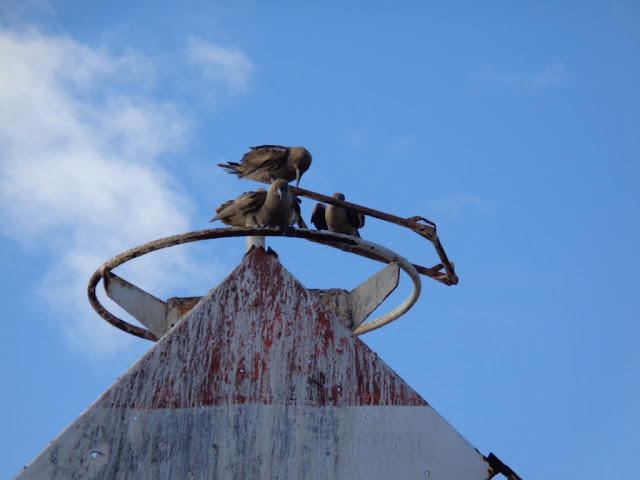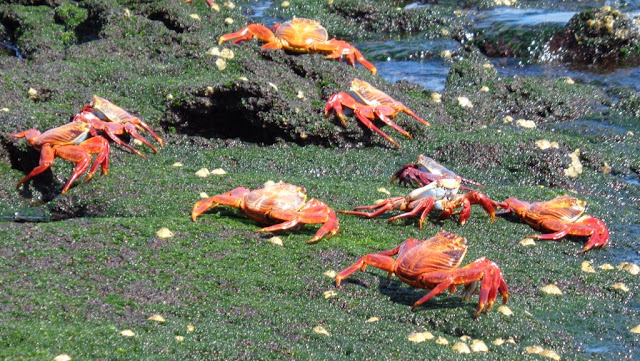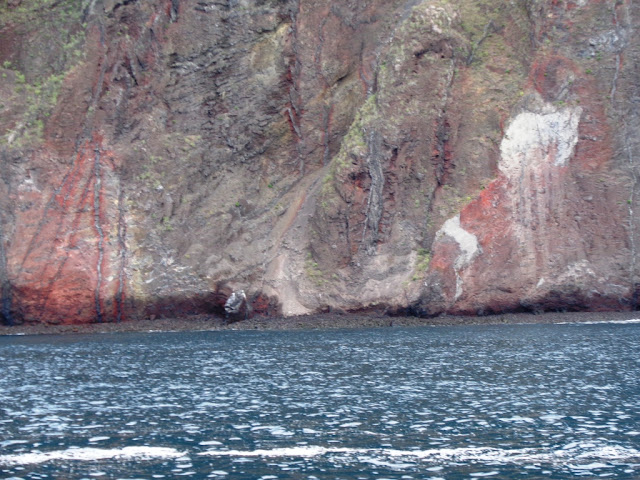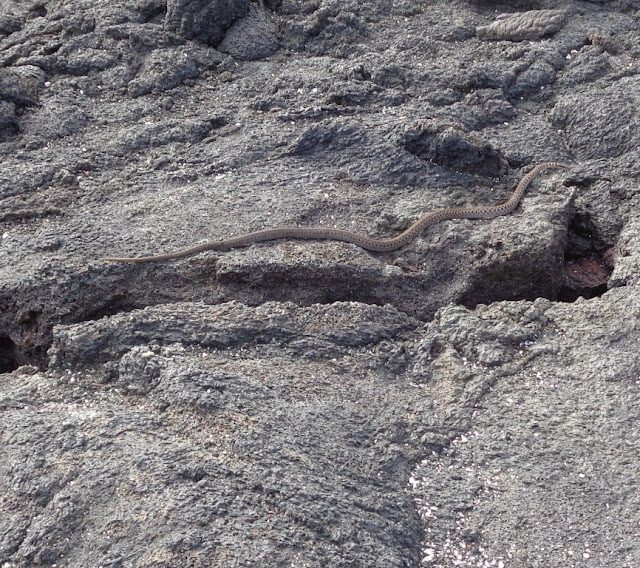Just over a year ago, I spent a week exploring the Galapagos before returning home to Canada. As I was planning my trip to South America, I wanted to
include a trip to the Galpagos Islands – after all, I wasn’t ever going to be
that close again. Kirsten, with
Odyssey Overland, had a connection to a local travel company (
Columbus Ecuador Travel in Quito)
who gave me a few recommendations, and then took care of all of the details to
get me from my hotel in Quito to and from the Galapagos Islands and then onward
to Cuenca and back to Quito.
I spent 8 days on the
Beagle with an incredible crew and guide
and 10 fellow travelers.
We explored the
northwest of the Galapagos islands and with great weather and opportunities to
snorkel, hike and explore I learned incredible amounts of interesting stuff and
still can’t believe how up close and personal we got with the inhabitants.
I knew before arriving that Charles Darwin had only spent a
brief time on the Galapagos – less than a month out of his 5 year journey
around South America as the naturalist on the Beagle. Mention of Darwin as we arrived felt like
bumping into an old friend as it seemed that everywhere I had been in South
America also had a connection. What
fascinated me more, was our guide’s description of how Ecuador is attempting to
manage the islands and balance the pressures of tourism, protecting a fragile
environment and demands by people on the mainland to be allowed to work and
live there. You can only live and work
on the Galapagos if you are local – born there or married to a local. This means that Ecuadorans on the mainland,
as well as other South Americans allowed by treaty to work freely in Ecuador,
can’t come to work where the economy and standard of living is much
higher. What this means, though, is that
the number of tourists is controlled by the fact that you must come with a
local company employing locals.
I have hundreds of photos of my time and even more
memories. I had worried that I wouldn’t
get any photos of my time as I was using a very basic digital camera that
replaced my faithful Canon Powershot that had suffered just too many
injuries. Not to worry, as you will see from
the following selection. The animals
have no fear of humans, and predators are carefully kept away (boats and planes
are carefully searched for rats who may have come from the mainland). We actually had to walk carefully to not step on iguanas,
crabs, or birds. The request to not
touch the animals while snorkeling was met with a smile, because the seals and
turtles actually came up to explore us.
Our itinerary
Follow the map from the north of Santa Cruz Island where the
airport is, north to Genovesa and then over to Puerto Egas on Santiago, then around
the top of Isabella where we hopped down the coast, over to Fernandina and then
overnight at Puerto Villamil (where many of our crew were from and where I
posted postcards over a lunch break) to the southern tip of Santa Cruz where we
then drove back to the airport by way of some incredible scenery and a sweet
wee attack owl.
I’d like to thank the captain and crew of the Beagle for a
fantastic experience. Jan, our guide,
who is originally from the Netherlands but is married to a local girl (and
fellow guide) gave an incredible two sided perspective on the Galapagos. My fellow travelers, who generously shared
photos and experiences, made the journey a delight. Pablo, from Columbus Travel, we only shared
emails, but you found a great ship, planned the journey, and had someone
waiting to shepherd me through the complexities of being a solo Anglophone in a
busy Spanish speaking world.
The Beagle (pretty Gucci home for a week)
 |
| My own cabin, ensuite including this lovely sink. |
 |
| crew bringing in the dinghy |
 |
| Peter also got to help (us ladies were never asked) |
 |
| Frigate bird checking us out |
 |
| Coming into the ship with the sunset |
 |
| Pretty darned good photo with a wee point and shoot |
 |
| Yes, we found Nemo. Actually, he kept following us. |
Birds of the Galapagos
Many of my fellow travelers were dedicated birders and could name all the birds we were seeing. I just went with the flow and watched them with awe (and got to swim with a penguin).
 |
| This is what "auto correct" did for my photo. |
 |
| Baby something (they were all cute and fluffy and almost as big as their parents) |
 |
| Frigate bird (I think) |
 |
| Red footed boobies on Prince Philip's steps. More rare than the blue footed ones. |
 |
| Frigate bird circling and watching for boobies to catch a fish that he would then steal |
 |
| Looking wise, and perhaps a bit irritated (or sleepy) |
 |
| Mum and baby boobie |
 |
| Bad hair day |
 |
| We watched the flightless bird (below) figure out how to get down to the water and out to sea. |
 |
| Success |
 |
| Another pretty darned good photo from my wee point and shoot camera. Maximum zoom while bouncing around in a dinghy in a cave. |
 |
| Coming out of one of the caves we explored. |
 |
| Finally, a blue footed booby |
 |
| Galapagos penguin - rare, but we saw them in three different locations, including one when we were snorkeling :) |
 |
| My photo, but Paul and Eilish (from Vancouver) labeled all their shared photos and say this is a yellow warbler. |
 |
| Penguins swimming around us |
 |
| Pelican dropping into the water to catch a fish. He'd then hope it wouldn't get stolen in mid air by a frigate bird. |
 |
| Young birds get as big as their parents very quickly - something about aerodynamics and learning to fly |
 |
| More penguins. The fluffy ones are the chicks who are molting their first feathers for waterproof ones. |
 |
| The story of this cute attack owl. He was just standing on the path our last day but got quite perturbed by Peter's camera and came charging up. We figured he had seen his reflection in the lens and felt challenged. |
 |
| Peter shared some fantastic photos, but I got the action shot of this little fellow attacking him. |
Iguanas (land and water)
On the Galapagos, iguanas have adapted to hunt in the water and are actually more common than their land based relatives. On land, (like the sea lions), they were resting and drying out after a long day's work, so couldn't be bothered to move away from us.
 |
| Coming out of the airport. I was so excited to see my first animal... not realizing that the water iguanas were everywhere |
 |
| Much less common, we stopped to watch this fellow cross our path (and he stopped for photos) |
 |
| The trail of a land iguana |
Turtles (everybody wants to see turtles)
We stopped to see turtles at the breeding center on Isabella, but before that, on Fernandina, we had seen a young female - the main colony was in the crater and only accessible by scientists with a special permit - but pressures for territory would make the young ones come down off the mountain. Like we had seen in Indonesia, the focus is on protecting the breeding grounds and the tiny turtles who are so vulnerable to predators as they make their way to the ocean.
 |
| Demonstration turtle shell. |
 |
| And here is the young female. We watched carefully and quietly so that she wouldn't desert the nest. |
 |
| Turtles at the breeding center. The young are released to the wild |
 |
| And a chicken with the turtles (not sure if it was crossing the road or not) |
 |
| These turtles were heading our way, associating people with food. |
 |
| These turtles, a different subspecies, had been rescued from one of the volcanic eruptions. This explained the scarred and disfigured shells. The population has reestablished with the young from these turtles. |
 |
| Under the altar of a very interesting church in Puerto Villamil |
Sea Lions
I've seen sea lions in a number of locations, but never so close. We swam with them (apparently if you are comfortable enough with snorkeling that you can do a back flip, they will come up to play with you) and got to see their new babies. On the Galapagos, there is no breeding season and babies are born year round.
 |
| Exhausted after a long hunt |
 |
| Gunther was doing an excellent job of imitating this lady sea lion ... |
 |
| ...and her mate came charging out of the water to defend her... |
 |
| successfully making the challenger run away. |
 |
| This baby was only a few hours old |
 |
| Doesn't look really comfortable to me... |
 |
| One of the seals that hopped into the water to swim with us |
 |
| These babies were a couple of days old - mum was out fishing and left them near other females |
 |
| This wee fellow was less than an hour old - mum hadn't yet cleaned herself up, the crabs were still eating the placenta and baby hadn't figured where on mum to nurse (needed a lactation consultant, perhaps?) |
 |
| This is how close the animals let us come. |
Crabs and whales and other beasties
Wherever there were other animals, you could count on seeing Sally Lightfoot crabs. We also chanced on a pod of blue whales on one of our sail days.
 |
| Ray |
 |
| A wee critter climbing about on the lava. The Galapagos is a combination of volcanoes and coral. |
 |
| The light was just right to catch this ray at quite a distance with the water almost invisible |
 |
| A blue whale checking out the Beagle |
 |
| Peter's photo |
 |
| And Peter's photo of a Mola Mola that was also following us |
 |
| Sea turtle in the water |
 |
| The problem with fighting for the lady, the loser gets eaten |
 |
| Another wee critter camouflaged on the lava. Not one of the stars of the islands, but fascinating because they were few and far between. |
 |
| Whale skeleton - it had been beached by a tsunami wave |
 |
| turtles on a rock |
 |
| A kind of starfish |
 |
| The whale skeleton up close - notice the distance from the water |
 |
| More rays |
Sunsets, scenery and responsibly collected seashells
In between the animals of the Galapagos, there was also incredible scenery, which to this quilter just spoke to my love of colour, shape and texture. I continue to be fascinated while traveling with how each sunrise and sunset is so special and different to what I expect at home.
 |
| This is the remains, impregnated with salt, of a dock. You could see evidence of settlement throughout the island. People either left for better places, or got resettled when Ecuador created this as a natural heritage site. |
 |
| Chinese Hats (limpets) my first favorite seashell |
 |
| Even out of focus, its a fascinating study in shape and texture. We were exploring a cave by dinghy, and my wee camera did its best. |
 |
| A piece of lava |
 |
| The Galapagos has it's own tropical rain forest which leads up to a cloud forest. Very tiny(in proportion to the size of the islands) with their own plants and animals. After sticking to the shore for most of the journey, it was great to head inland to check out a very different environment. Sure it was drizzly and foggy (in the cloud forest, we did not get to see the extinct volcano crater), but without rain, there is no greenery. |
 |
| Wild coffee plant (beans not yet ripe) |
 |
| Coffee beans. Not yet roasted. |
 |
| Jan, trying out the mushrooms, which he was taking home for lunch. |






















































































































































































































































